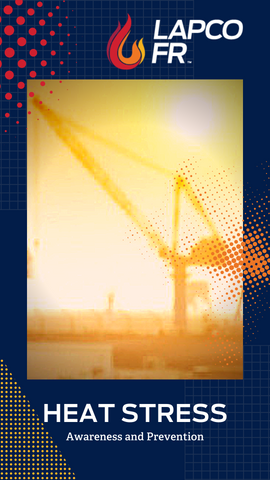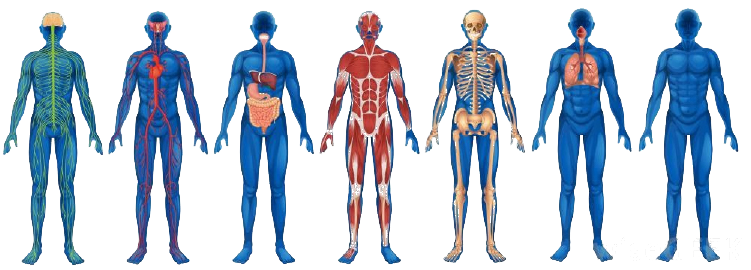What is Heat Stress? Occupational heat stress is the net load to which a worker is exposed from the combined contributions of metabolic heat, environmental factors, and clothing worn which results in an increase in heat storage in the body.

Heat stress can result in a variety of heat-related illnesses, such as heat stroke, heat syncope (fainting), heat exhaustion, heat cramps, or heat rashes.
The Physiology of Heat Stress
The human body is an amazing machine designed to accommodate rigorous abuse.

We have built-in mechanisms that attempt to prevent and repair injuries.
Heat from Environmental Factors & Physical Activity elevates the body’s core temperature and causes physiological responses as the body attempts to prevent heat injury or illness through thermoregulation.
Core Temperature
: the temperature of the deep tissues of the body. (Organs in the cranial, thoracic, and abdominal cavities)
Surface Temperature
: the temperature of the skin, subcutaneous tissue, and fat. (Commonly referred to as the shell or periphery)
Thermoregulation
: the maintenance or regulation of temperature specifically: the maintenance of a particular temperature of the living body.

The Body’s Response to Heat
The body tries to maintain a constant internal temperature. When the internal temperature rises, the body attempts to get rid of excess heat by:
- Increasing blood flow to the skin surface
- Releasing sweat onto the skin surface
Effects of the Body’s Response to Heat
Reduced blood Flow to Brain
- Reduced Mental Alertness and Comprehension
Reduced Blood Flow to Active Muscles
- Fatigue
- Loss of Strength
Increased Sweating
- Dehydration Rate is Accelerated
- Slipperiness
- Skin Irritation
These effects can lead to heat-related illnesses.
Contributing Factors of Heat Stress
Dehydration: A Risk Factor for Heat-Related Illness
Overview
- Dehydration occurs when you use or lose more fluid than you take in, and your body doesn't have enough water and other fluids to carry out its normal functions. If you don't replace lost fluids, you will get dehydrated.
- When it's hot and humid, your risk of dehydration and heat illness increases. That's because when the air is humid, sweat can't evaporate and cool you as quickly as it normally does, and this can lead to an increased body temperature and the need for more fluids.
- You can usually reverse mild to moderate dehydration by drinking more fluids, but severe dehydration needs immediate medical treatment.
- Thirst isn't always a reliable early indicator of the body's need for water. Many people, particularly older adults, don't feel thirsty until they're already dehydrated. That's why it's important to increase water intake during hot weather or when you're ill.
Symptoms of Dehydration
- Extreme thirst
- Less frequent urination
- Dark-colored urine
- Fatigue
- Dizziness
- Confusion
- Loss of Appetite
- Dry Skin
- Dry Mouth
- Weakness
- Chills
- Head Rushes
Many prescription and OTC medicines warn of dehydration.
Avoid alcohol before or during working in the heat. Alcohol dehydrates the body.
PPE: A Risk Factor for Heat-Related Illness
PPE can:
- Reduce the body’s normal way of getting rid of heat by sweat evaporation.
- Hold excess heat and moisture inside PPE, making the worker’s body even hotter.
- Increase the physical effort to perform duties while carrying the extra weight of the PPE.
Other risk factors for Heat-Related Illness include:
- Age - Elderly and Children Under 5 are at higher risk
- Weight
- Physical fitness
- Pregnancy
- Metabolism
- Medical conditions-
hypertension, diabetes
Manifestations of Heat Stress
Heat-related illnesses can vary in symptoms and severity.
- Heat Rash
- Heat Cramps
- Heat Syncope
- Heat Fatigue/
- Exhaustion
- Heat Stroke

Heat Rash
- Heat rash, also called “prickly heat” is a skin condition that can affect skin in hot weather.
- The rash usually occurs when your sweat ducts become blocked and perspiration is trapped under your skin. Heat rash often occurs in the summer or in humid climates.
- Adults can experience heat rash when they are dressed too warmly or when they stay outside too long in hot and humid weather.
- A common sign of heat rash is a cluster of red bumps that resemble pimples on the skin.
- The most common places for heat rash to occur are the face, neck, under the breasts, and the groin. It can also appear in skin folds and in areas of the body that rub against clothing such as the inner thighs, back, chest, and stomach. These are all places that tend to sweat more often.
- Severe heat rashes may blister and become infected if not treated properly.
Heat Cramps
- Painful, brief muscle cramps (usually involving the legs, chest, or abdomen) that occur during or after exercise or work in a hot environment. Muscles may spasm or jerk involuntarily. Cramping may also be delayed and occur a few hours later.
- Heat cramps are thought to be caused by a deficiency in electrolytes. Electrolyte dilution can arise from performing hard work in hot environments, heavy sweating, and excessive water intake.
Heat Syncope (Fainting)
- Sometimes called Heat Collapse.
- Heat syncope is fainting or dizziness because of overheating (syncope is the medical term for fainting). It is a type of heat illness. The basic symptom of heat syncope is fainting, with or without mental confusion.
- Heat syncope is caused by peripheral vessel dilation, resulting in diminished blood flow to the heart & brain, and dehydration.
- Heat syncope occurs in a warm environment when blood pressure is lowered as the body dilates (widens) arterioles (small blood vessels) in the skin to radiate heat.
- This condition occurs within five days of heat acclimatization, before the blood volume expands. The result is less blood to the brain, causing light-headedness and fainting when a person stands up quickly or stands for a long period of time.
- Those who perform strenuous work outside in warm climates are at particular risk.
Heat Fatigue (Exhaustion)
Heat exhaustion is a severe form of heat illness. It is a medical emergency. Heat exhaustion is caused by the loss of water and electrolytes through sweating. Someone suffering from heat exhaustion may exhibit impaired performance of skilled sensorimotor tasks or mentally & physically challenging jobs.
Common causes of heat exhaustion include:
- Hot, sunny, humid weather
- Physical exertion, especially in hot, humid weather
- Due to impaired thermoregulation, elderly people can get serious heat illness even at rest, if the weather outside is hot and humid, and they are not getting enough cool air.
- Some drugs, such as diuretics, antihistamines, beta-blockers, alcohol, ecstasy, and amphetamines can cause an increase in the risk of heat exhaustion.
Especially during physical exertion, risk factors for heat exhaustion include:
- Wearing dark, padded, or insulated clothing; hats; and/or helmets
(for example, turnout gear) - Having a higher percentage of body fat
- Dehydration
- Fever
- Some medications, like beta-blockers and antipsychotic medicines
Heat Fatigue/Exhaustion Symptoms
- Nausea
- Dizziness
- Irritability
- Headache
- Thirst
- Weakness
- High Body Temperature
- Excessive Sweating
- Decreased Urine Output
- Vertigo
Heat Stress Prevention
Drink plenty of fluids.
Water =
- 1 cup (8oz.) every 15 minutes or
- 4c (32oz.) each hour
- Do not use thirst as a gauge for dehydration.
- Drink plenty of fluids before, during, and after you begin work.
Pure Water vs. Electrolyte Drinks
- Electrolytes - minerals (magnesium, potassium, sodium, and calcium) that are lost through perspiration or other forms of dehydration, particularly in heat stress situations.
- Water absorbs slowly into the body.
- Studies show that some electrolyte drinks help the body to absorb water 98% faster than water alone.
Avoid soft drinks and caffeinated products.
Wear clothing that is
- Relaxed fitting
- Light-colored
- Lightweight
- Breathable
Minimize your exposure to the sun.
Industrial Safety Umbrellas for sun protection.
Eat light, cool meals.
- Hot and heavy meals add heat to your body.
- Hot meals divert blood to your digestive system that would normally help cool you off.
Understand the role of Relative Humidity.

Heat Safety Training
- Know the hazards of heat stress.
- Be aware of your working environment.
- Watch for danger.
Be Prepared:
- Training in First-Aid Procedures.
- Have an action plan in place.
Employer Responsibilities
When the heat index is expected to be dangerous, employers must protect employees. NIOSH recommends that employers establish a heat-related illness prevention program that includes the following measures:
- Training for supervisors and workers to prevent, recognize, and treat heat-related illness
- Implementing a heat acclimatization program for workers
- Providing for and encouraging proper hydration with proper amounts and types of fluids
- Establishing work/rest schedules appropriate for the current heat stress conditions (an industrial hygienist may need to be consulted)
- Ensuring access to shade or cool areas
- Monitoring workers during hot conditions
- Providing prompt medical attention to workers who show signs of heat-related illness
- Evaluating work practices continually to reduce exertion and environmental heat stress
- Monitoring weather reports daily and rescheduling jobs with high heat exposure to cooler times of the day
Employee Responsibilities
Employees are urged to protect themselves. To protect yourself as an employee, do the following:
- Drink water or other liquids frequently enough to never become thirsty (about 1 cup every 15–20 minutes). Hydration is the most important tool in preventing heat-related illness, and workers should try to be well-hydrated before arriving at work.
- Eat during lunch and other rest breaks. Food helps replace lost electrolytes.
- Wear light-colored, loose-fitting, breathable clothing such as cotton.
- Wear a wide-brimmed hat when possible.
- Take breaks in the shade or a cool area when possible.
- Be aware that protective clothing or personal protective equipment may increase the risk of heat stress.
- Monitor their physical condition and that of coworkers.
- Tell their supervisor if they have symptoms of heat-related illness.
- Talk with their doctor about medications they are taking and how the medications may affect their tolerance of heat.



Back to FR Education & Guides